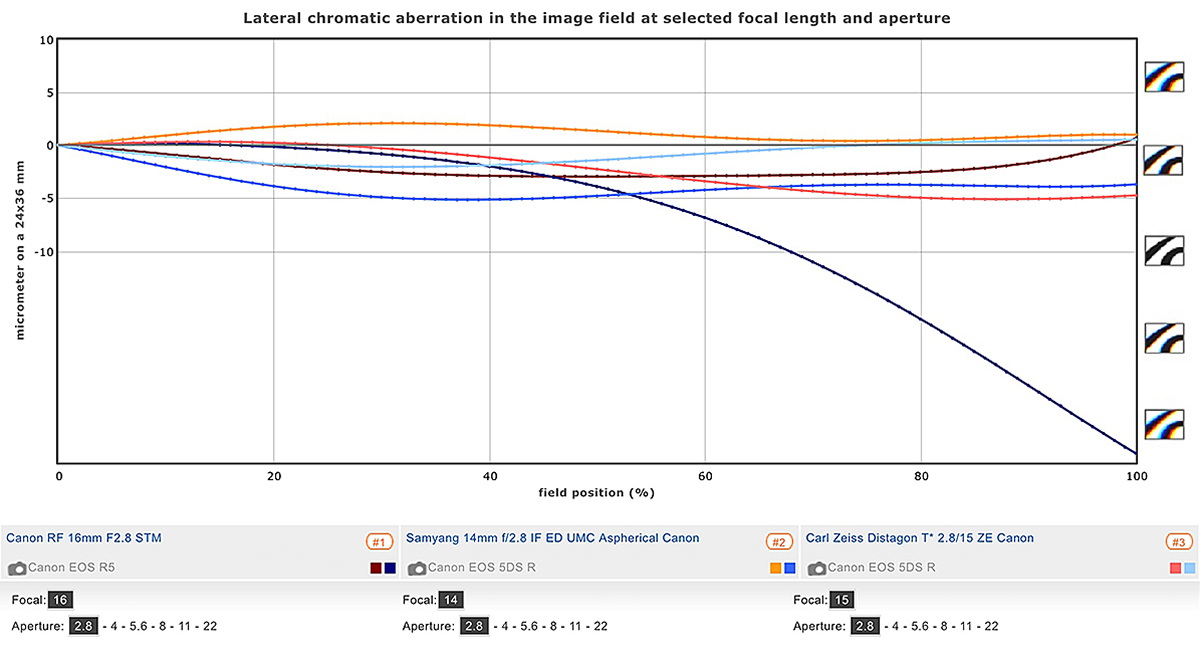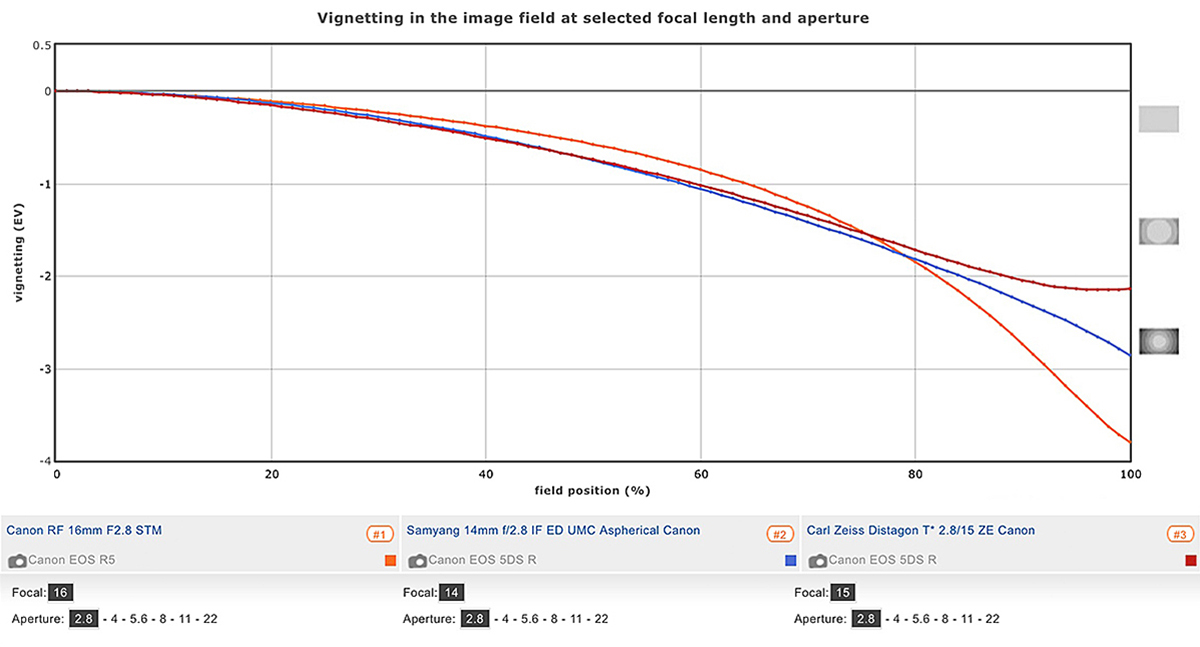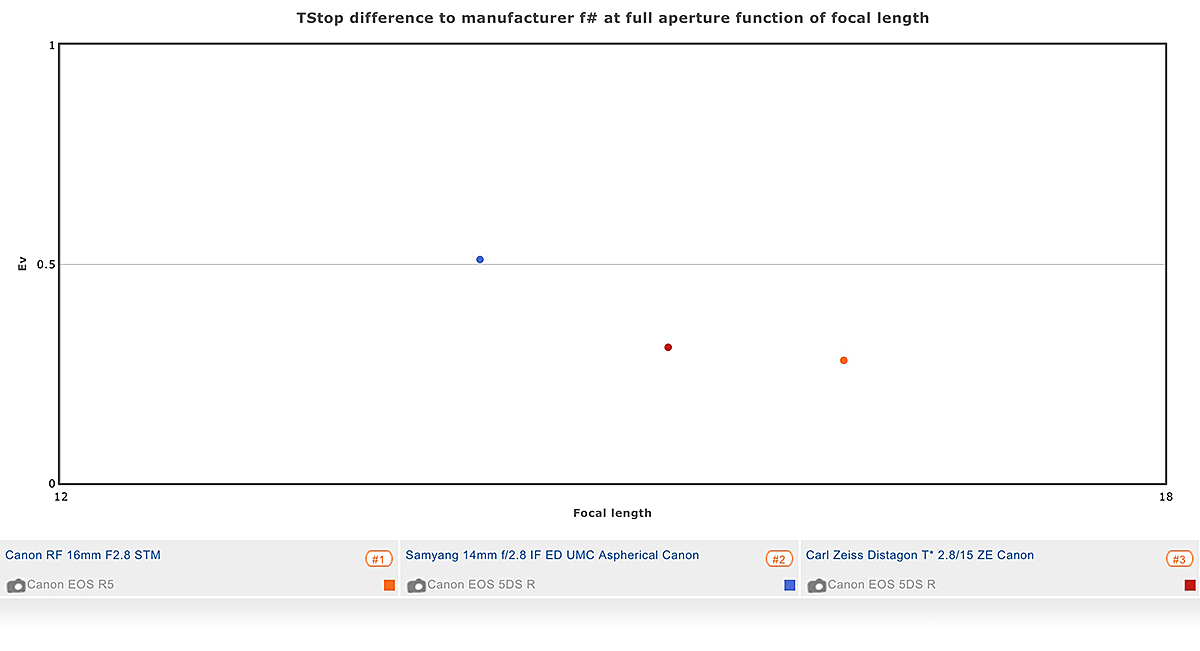Designed for Canon’s RF-mount mirrorless full-frame cameras, the Canon RF 16mm F2.8 STM is a compact and lightweight ultra-wide lens for trekking, landscapes and architecture.
It features nine elements, one of which has an aspherical surface, all arranged in seven groups, and it employs Canon’s Super Spectra Coating to reduce ghosting and flare. The lens adopts a stepper-type (STM) AF motor for smooth and quiet focusing. It has a minimum focus distance of just 0.13 m (5.1″) and a maximum magnification of 0.26x.
Externally, the lens has a single control ring for manual focus or it can be allocated with another function from the camera, if desired. With a 43 mm filter thread, the lens is highly compact for a relatively ‘fast’ ultra-wide and it’s lightweight, weighing just 165 grams (0.36 lb).
You can view the results for all tested lenses and create your own comparisons and in-depth analyses using our interactive image lens comparison tool.
Key specifications:
- Nine elements in seven groups
- One aspherical lens surface
- Seven blade, rounded aperture
- STM AF motor
- 43 mm filter thread
- Minimum focus distance: 0.13 m (5.1″)
- Weight: 165 grams (0.36 lb)
Test results
We tested the Canon RF 16mm F2.8 STM on the 45 MP Canon EOS R5, where the camera sensor and lens together achieved a DXOMARK score of 30 points. This is a good score for an ultra-wide lens and among the best tested in this range.
Touted as an affordable model, this new lens actually has very good sharpness, especially wide open at F2.8 and at F4 in the center. Stopped down, the sharpness remains relatively high in the centers, though there’s a drop in performance from the middle of the field and out to corners.
Transmission is another highlight, with it measuring an efficient T3.1. This is just -0.3 EV below the stated F2.8 full aperture. However, there are some downsides to using embedded profiles to supplement optical correction, which isn’t taken into account with our tests and DXOMARK score. Consequently, vignetting (peaking at -3.8 EV), barrel distortion (measured at 4.7%) and chromatic aberration (averaged at 27 µm) are all high without the correction profiles applied, which is how we present our results.
Overall though the Canon RF 16mm F2.8 lens is a good performer, especially given the price and compact size. As always, it’s worth looking through the more detailed data to see how the lens performs at the various aperture settings.
In-depth comparisons
The profile-assisted Canon RF 16mm F2.8 is the first ultra-wide fixed focal length lens we’ve tested in our lab for the RF mount. So, we’ve compared it on the 45 MP Canon EOS R5 with two retro-focus (inverted telephoto) designs for DSLRs at different ends of the price scale. The Samyang 14mm F2.8 IF ED UMC Aspherical is a competitively priced manual focus lens designed for the EF mount. We’ve mounted it on the 50 MP Canon EOS 5Ds R, which, according to Canon Japan, has a similar resolving power to the slightly lower pixel count sensor in the Canon EOS R5. We’ve also compared the Canon RF 16mm F2.8 with a state-of-the-art manual focus design from Zeiss: the Distagon T* 15mm F2.8 ZE, again fitted to a Canon EOS 5Ds R.
You can see an overview of this comparison in our database.
Sharpness
The Canon RF 16mm F2.8 performed especially well in sharpness (acutance) testing. It has very good center sharpness with average uniformity at the maximum aperture of F2.8 achieving a high 80% acutance in the center, falling gradually to just under 65% out to the corners. It has similar center sharpness at F4 as well, along with a slight improvement towards the edges and corners. However, there’s some slight astigmatism-like behavior in the 60-80% field position. After that, from F5.6 and onwards, sharpness levels in the periphery fall as it’s stopped down. In many respects, the more expensive Zeiss performs very similarly to the Canon over F2.8-4, including some slightly more pronounced astigmatism-like characteristics. From F5.6 and on, however, it has very slightly improved edge sharpness over the Canon. The Samyang, on the other hand, can’t quite match the sharpness of either the Canon or Zeiss until stopped down to F5.6, but it’s not far behind and at F8 it has very good uniformity across the field.
Chromatic aberration
RAW files and out-of-camera JPEGs are mostly compensated for by built-in (embedded) profiles with Canon RF 16mm F2.8 STM, but some may be forced on with no option to turn them off, though that will depend on your choice of RAW converter. What’s more, the effectiveness of the corrections is likely to vary between converters. Without the profile applied the Canon has very high levels of lateral chromatic aberration, in excess of 25 µm at every aperture. Neither the Zeiss nor the Samyang adopts embedded profiles and both are well corrected. Of those two, it’s the more expensive Zeiss that has the lower levels of chromatic aberration but there’s not much between them despite the price difference.
Geometric distortion
Distortion is another aberration that’s automatically compensated for by an embedded profile in the Canon lens. Without it, though, it has exceptionally high levels of barrel distortion, measured at -4.7%. That said, when the profile is applied, RAW and JPEG files would be mostly corrected well enough. Like the final lateral chromatic aberration result, though, that would depend heavily on the effectiveness of the conversion software rather than the lens itself. As you might expect the Zeiss is the best optically corrected of the three, which accounts for the high price and large size. As a result, it has very low levels of barrel distortion (-0.5%) for an ultra-wide like this. The Samyang, by contrast, has significantly higher levels of barreling, measured at -1.6%, and would be much more noticeable.
Vignetting (corner shading)
Vignetting is the third aberration that’s automatically compensated for on the Canon lens, depending on your choice of RAW converter. While seemingly harmless and easy to correct by selectively adjusting the density, large corrections can leave unwelcome noise. As a result, the Canon’s uncorrected vignetting wide open at F2.8 in the extreme corners is very high, measured at -3.8 EV. And, vignetting remains high when stopping down, losing around -1 EV for each aperture stop down to F5.6, where after that it stays at around -2 EV regardless of the aperture setting. That’s in contrast to both the Samyang and Zeiss where the vignetting is lower: close to three stops in the former and just over two stops in the latter, when set at their respective maximum apertures. What’s more the pricier Zeiss maintains the lower levels when stopped down, which is what you might expect in a high-grade lens.
Transmission
The measured T-stop relative to the quoted F-stop is nice to know if you’re using your lenses for videography, and Canon suggests the lens might appeal to vloggers, but it isn’t really relevant for stills. Transmission may indicate how that lens handles flare and ghosting, but that’s not what’s tested here. In any case, this is one area where the Canon lens isn’t affected by a built-in profile and it performs well in that regard. It has the same 3.1 T-stop measurement as the Zeiss, which is -0.3 EV difference against the reported F-stop. The Samyang measures 3.5 T-stop, which is -0.5 EV behind the stated F-stop (F2.8).
Conclusion
With the introduction of the Canon RF 16mm F2.8 STM, Canon continues to explore new and innovative lenses for the RF mount. In an effort to reduce the optical complexity, thereby driving down the size, weight and cost, lens correction profiles make a lot of sense. Even without taking software correction into account, in our DXOMARK Lens test, the Canon RF 16mm F2.8 STM performs very well in certain key areas. It has, for example, similar sharpness and transmission to the larger and pricier Zeiss Distagon T* 15mm F2.8, while being much smaller and lighter. More importantly, especially for anyone on a tight budget, it’s around one-eighth of the price of the Zeiss and around the same price as the Samyang 14mm F2.8, making the Canon RF 16mm F2.8 STM a highly tempting option.
In this review, we have compared the Canon RF 16mm F2.8 STM mounted on a Canon EOS R5 to its closest rivals from other brands. Remember that the lenses may be used on various cameras with different sensors, or in some cases on different camera systems using different mounts, so the results will vary between them.
As usual, you can create your own comparisons and in-depth analyses using our interactive image lens comparison tool.











DXOMARK encourages its readers to share comments on the articles. To read or post comments, Disqus cookies are required. Change your Cookies Preferences and read more about our Comment Policy.